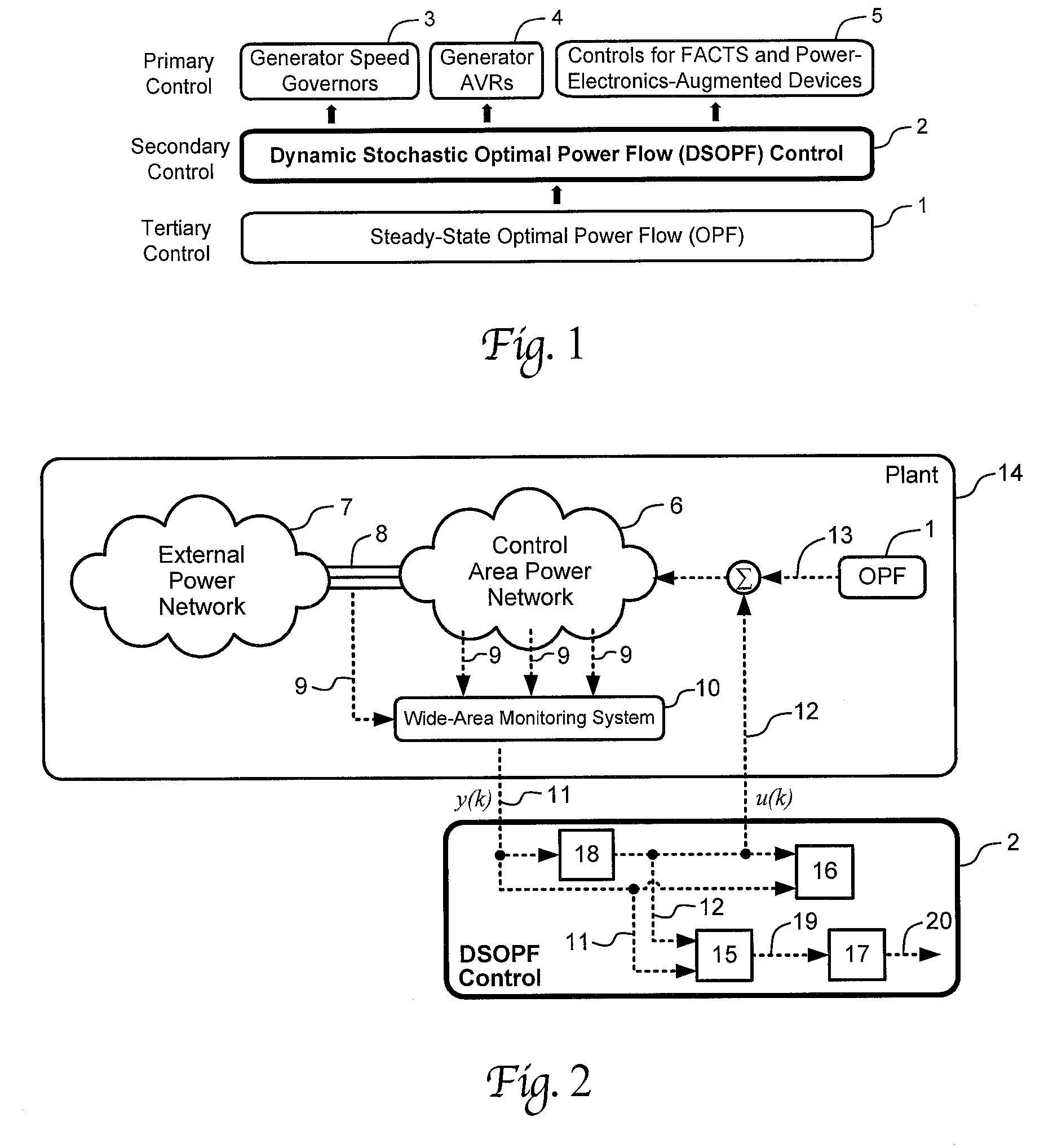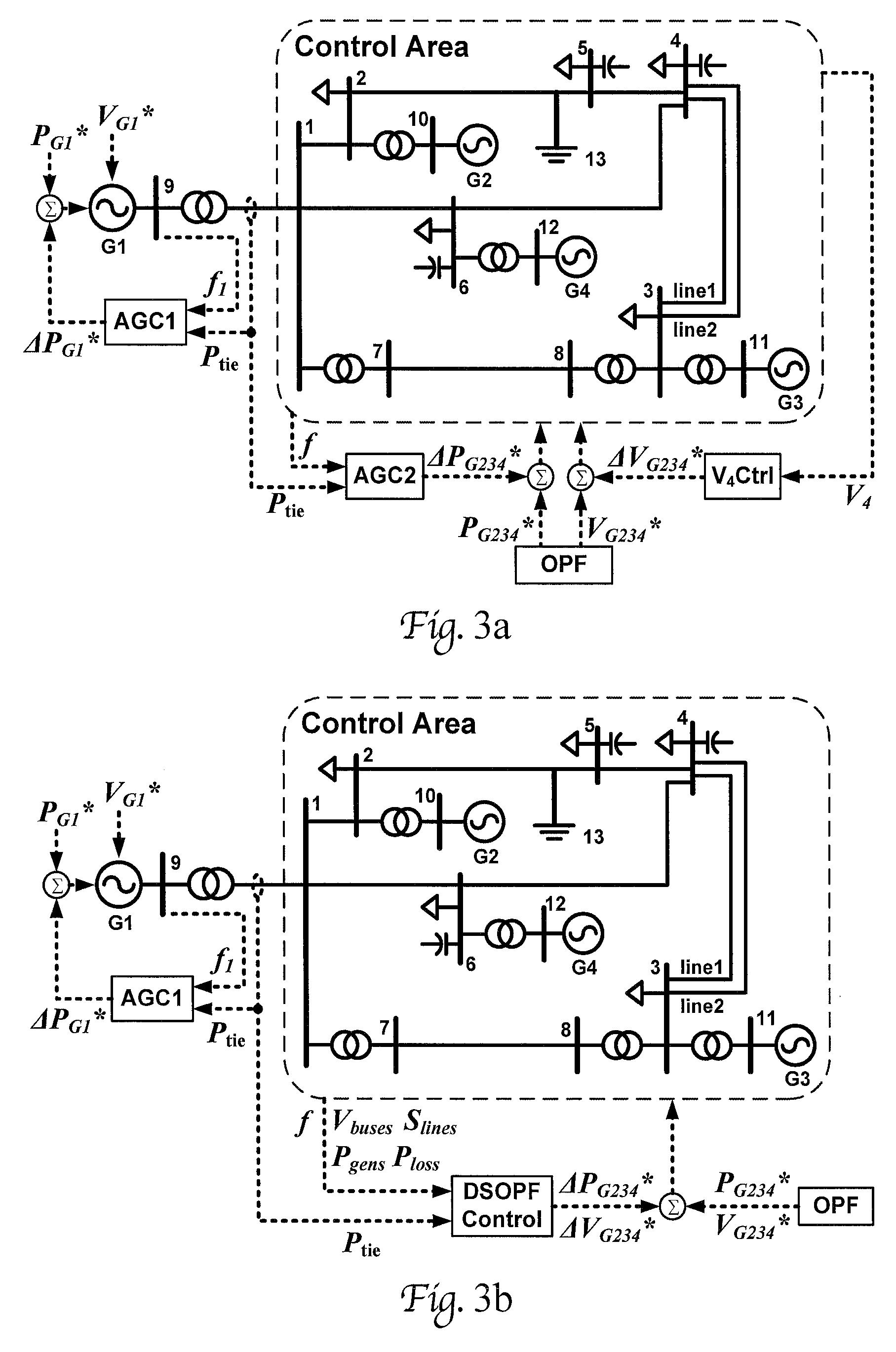Method and System for Dynamic Stochastic Optimal Electric Power Flow Control
a power flow control and stochastic optimal technology, applied in the direction of electric variable regulation, process and machine control, instruments, etc., can solve the problems of large amount of wind curtailment, unanswered challenging questions, and the inability to reliably and efficiently operate a power system in such an environment, so as to improve the stability of an electrical grid, maximize the system stability margin of said electrical grid, and minimize the control effort in the electrical grid
- Summary
- Abstract
- Description
- Claims
- Application Information
AI Technical Summary
Benefits of technology
Problems solved by technology
Method used
Image
Examples
example 1
Method for Power System Secondary Control
[0071]The invention includes many components and variations comprising multiple embodiments. One embodiment of the invention is a method of coordinating secondary control in a power system, namely the dynamic stochastic optimal power flow (DSOPF) control 2 as indicated in FIG. 1, which illustrates a new power system operation-control structure using a novel DSOPF control method. An existing optimal power flow (OPF) method 1 provides steady-state commands directly to local controllers, which include generator speed governors (GOV)s 3, generator automatic voltage regulators (AVRs) 4, and controls for FACTS and power-electronics-augmented devices 5. In contrast to the prior art OPF method, the DSOPF method 2 in the secondary control layer controls both the active and reactive power flows simultaneously to obtain an optimal real-time dynamic dispatch.
[0072]A generic framework of the DSOPF control 2 is illustrated in FIG. 2. The control area power...
example 2
[0100]Referring now to FIG. 12, a DSOPF is illustrated within a power system to replace the traditional linear secondary control used in most prior art grid control systems. The DSOPF controller provides nonlinear optimal control to the system-wide AC power flow using an adaptive critic design (ACD) technique. Here, “Gov's” represent governors, and “AVRs” represent automatic voltage regulators.
[0101]This embodiment of the invention can be illustrated in a large power system to demonstrate its effectiveness in controlling the active and reactive power flow in a traditional grid. The 70-bus system, as shown in FIG. 13, is developed from a 68-bus New England New York test power system. Area 1 with generators G1 to G9 (7650 MVA of total installed capacity) represents the New England Test System. Area 2 with generators G10 to G13 (14170 MVA of total installed capacity) represents the New York Power System. Generators G14 to G16 (10000 MVA each) are aggregated representations of three int...
case 1
Large Wind Power Variation
[0127]A large wind variation is applied to wind plants G17 and G18 starting at 300 s, as shown in FIG. 17. This example is used to study the controller performance in the presence of high wind variability.
[0128]In this example, no wind curtailment is generated from the area DSOPF controllers. With the same wind power variation, the area DSOPF controllers result in a lower overall utility than AGCs+SVCs, as shown in FIG. 18. In other words, a better overall quasi-steady-state performance is achieved by the area DSOPF controllers.
[0129]By leveraging the load-voltage characteristics, the DSOPF controllers result in less frequency variation, as shown in FIG. 19. The DSOPF controllers temporarily increase the voltage and thereby increasing load consumption, when the frequency is high. Neither the AGCs nor the SVCs can achieve this performance, since they decouple the active and reactive power control. AGCs do not control voltage, and SVCs do not respond to frequ...
PUM
 Login to View More
Login to View More Abstract
Description
Claims
Application Information
 Login to View More
Login to View More - R&D
- Intellectual Property
- Life Sciences
- Materials
- Tech Scout
- Unparalleled Data Quality
- Higher Quality Content
- 60% Fewer Hallucinations
Browse by: Latest US Patents, China's latest patents, Technical Efficacy Thesaurus, Application Domain, Technology Topic, Popular Technical Reports.
© 2025 PatSnap. All rights reserved.Legal|Privacy policy|Modern Slavery Act Transparency Statement|Sitemap|About US| Contact US: help@patsnap.com



